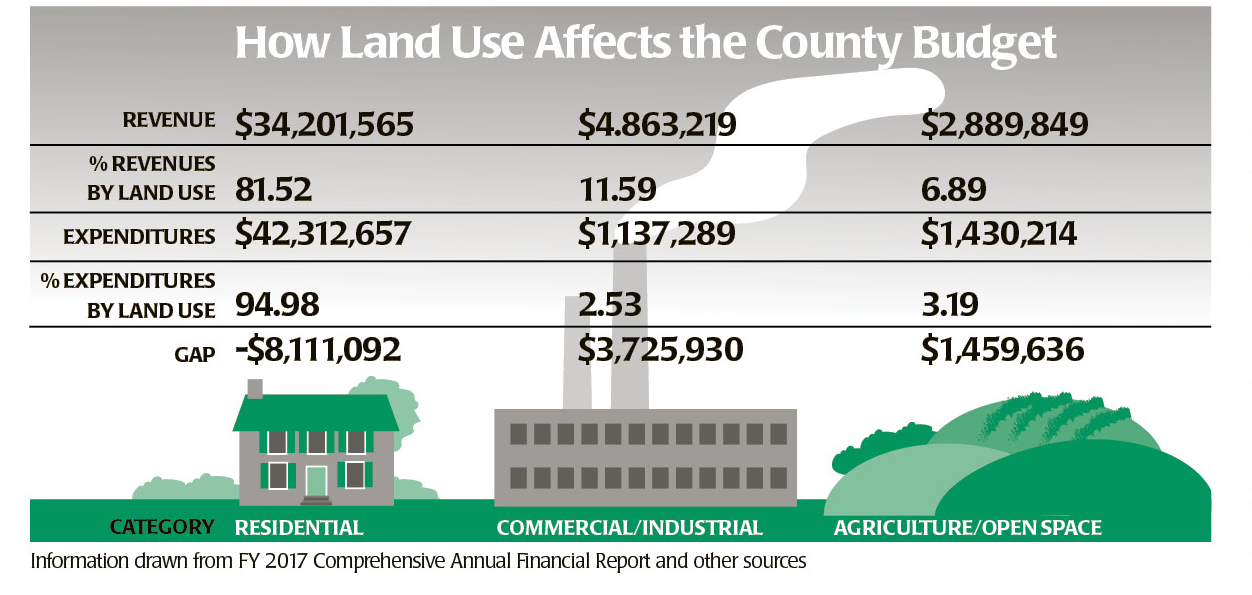Weldon Cooper Center for Public Service Completes a Cost of Community Services Study for Clarke County
Find the complete Cost of Community Services Study here.

For Small Communities, Land Use Remains “A Balancing Act”
Regional economist Terance Rephann, of the Weldon Cooper Center for Public Service at the University of Virginia, presented the results of a comprehensive Cost of Community Services study at an evening meeting of Clarke County’s Board of Supervisors in mid-October.
“While I don’t think the study’s statistics are surprising, it’s important for us to see firsthand – from an independent third party – how each of our land uses affects our county budget, in terms of income and expenses,” Alison Teetor explains. “That information truly is invaluable as we continue our land conservation mission.” Teetor is the natural resource planner for Clarke County and oversees the conservation easement program through the Conservation Easement Authority.
The statistics compiled are similar to those of a study for the county conducted more than a decade ago and comparable to data from other Virginia counties: Residential land use brings in the lion’s share (81.52 percent) of revenue to the county but also accounts for most of the expenditures (94.28 percent); in other words, for every $1 in revenue, the county spends about $1.24. Commercial/Industrial land use contributes 11.59 percent of revenue and requires 2.53 percent of expenditures; for every $1 in revenue, the county spends about $0.23. And Agriculture/Open Space land use accounts for 6.89 percent of revenue and 3.19 percent of expenditures; for every $1 in revenue, the county spends about $0.50.
For purposes of this study, land uses are defined in this way:
• Residential: Land and improvements used as a place of residence (e.g., single-family homes, apartments, mobile homes, and associated yards)
• Commercial/Industrial: Land and improvements used for buying, selling, and storing products and services and manufacturing goods
• Agriculture/Open Space: Farms, forests, and other privately owned open space
One interesting twist in the study, according to researcher Rephann: Clarke County’s formal conservation easement program has an impact on the calculations, slightly driving up the expenditures for Agriculture/Open Space. If the county invested no monies in land conservation, the expenditure/ revenue ratio would change from 0.495 to 0.314 for Agriculture/Open Space land use.
“Clarke County’s conservation easement program makes you unique,” Rephann noted. “Most communities don’t have them. But these results will provide an additional metric for your county’s decision-making.”
Board of Supervisors Chairman David Weiss commended the Conservation Easement Authority and Teetor for their ongoing land preservation work.
“I think we’re still on the right track,” he said. “The point is no one is saying residential is bad. These are just facts. But it’s interesting how studies bear out that land use is a balancing act. And it’s tougher for a small community to balance the three components.”
The Cost of Community Services study was co-funded by an Agriculture and Forestry Industries Development Fund grant administered by the Virginia Department of Agriculture and Consumer Services and the Stewardship Fund of the Clarke County Conservation Easement Authority; no county funds were spent on the study.
